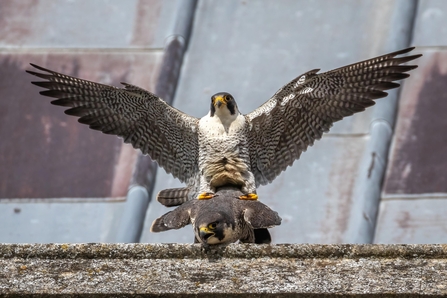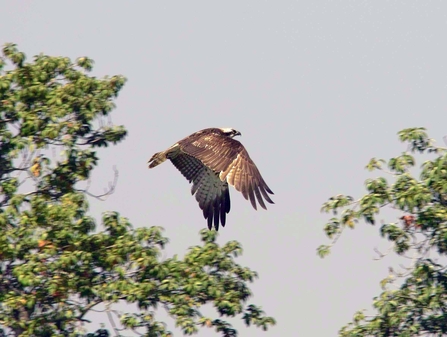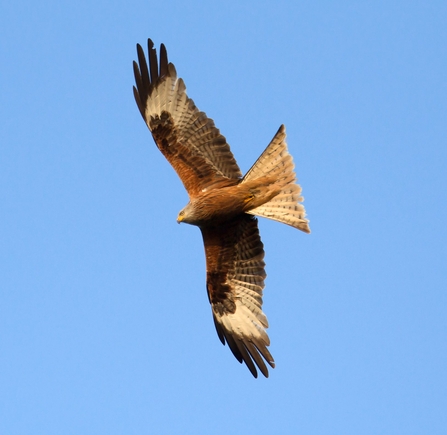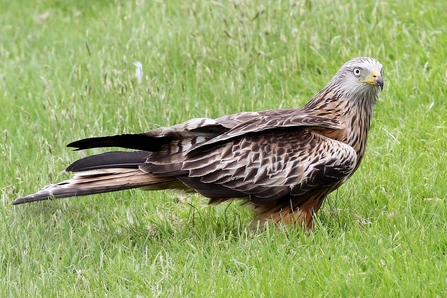Peregrine Falcon
Of course, we have to start with our local stars: Peregrine Falcons!
50% off membership
Artemis after fledging (c) Andrew Steele
Peregrine Falcon
Of course, we have to start with our local stars: Peregrine Falcons!

Alban and Boudica mating (c) Patrick Wainwright
The fast and powerful Peregrine Falcon has been revered by many ancient cultures throughout history. In Egyptian mythology, the god Horus had the head of a falcon, and was both a sun and falcon god. The eye of Horus – a human eye with the plumage pattern of a falcon’s cheek – was a symbol used to heal and protect against evil. Indigenous Americans believed that the bird was a messenger who brought guidance from the spirit world. And in Celtic folklore, the sight of a Peregrine Falcon was a reminder to be wary of dangers. Around here, it’s mainly the pigeons who have to watch out, as they are one of our Peregrine Falcons’ favourite food items.
Peregrine Falcons normally mate for life and often remain loyal to their nest site each year. Following the efforts of Barry Trevis and the Wilder St Albans project (a collaboration between St Albans City and District Council and Herts & Middlesex Wildlife Trust), this is Alban and Boudica’s third year of breeding on St Albans Cathedral. In 2022, their daughter Artemis successfully fledged on the 26th June and could be seen afterwards being taught the art of hunting by her dedicated parents, whilst 2023 saw the arrival of three brothers. This year, Boudica has laid three eggs, so we look forward to seeing what happens next!
Many of you are already keeping a close eye on the nest tray through St Albans Cathedral’s webcam, which you can find here. You can also join us and the St Albans Local RSPB Group outside the Cathedral every weekend through spring and early summer, to learn more and take a look at what our Peregrines are up to through our telescopes and binoculars! Our Peregrine Watch events run from Saturday 11th May until Sunday 16th June, 11am–3pm. See our Events page for more information.
There are also exciting projects underway with Peregrines in Watford - the birds are breeding on the YMCA and there is a newly-installed webcam there, plus a nest tray has been installed on the roof of Watford Football Club's stadium, with the hope that the birds may breed there.

Osprey (c) Derek Moore
Osprey
The large, unmissable Osprey is renowned for its ability to swoop down from a great height to snatch a fish from water. While many cultures revered the bird’s excellent fishing skills (the Ancient Romans believed it could mesmerise fish), this natural talent eventually led to the bird’s persecution. Monarchs resented their ponds being raided, and other humans wanting the fish for themselves did not appreciate the competition either. So, the Osprey became the victim of shooting, poisoning and trapping.
Habitat loss, water pollution and diminishing food sources were further reasons for the Osprey’s plummeting numbers. By the end of the 18th century, the Osprey had almost completely disappeared from Britain; by the end of the 19th century, Scotland was its only haven.
In 1954, the Protection of Birds Act was brought in by the Government, which helped to protect Ospreys and their eggs. Then the Wildlife and Conservation Act 1981 made it an offence to disturb, take, injure or kill an Osprey or its eggs or young, with fines and prison sentences as punishment. While Ospreys are still persecuted in some places today, through good education and conservation projects, many landowners now tolerate or even celebrate the return of Osprey.
One effective conservation method has been the provision of artificial nests, to encourage Ospreys to breed in new areas. Ospreys do visit us in Hertfordshire, usually when stopping to fish at lakes for a couple of days on their way north during their spring migration, and on their way back to Africa on their autumn migration. Last autumn, a nesting platform was erected at Stocker’s Lake, and we are hoping that another will soon be refurbished at Panshanger Park – so watch this space: perhaps it won’t be long until Ospreys choose to stay and breed in our county!

Red Kite (c) Tim Hill
Red Kite
Last but certainly not least, let’s look at the majestic Red Kite. Hertfordshire residents often comment that they now see this bird of prey nearly every day, unlike years ago. That’s due to a project that took place from 1989, reintroducing young Red Kites from Spain, Germany, Sweden and Wales to sites across Scotland and England, including the Chilterns. From these individuals, the number of Red Kites has grown and spread across the counties, including ours! Hertfordshire’s mosaic of woodlands, roads and fields is an ideal habitat for the Red Kite, as they nest in woodlands, eat roadkill and their favourite food is earthworms from farmer’s fields.
Red Kites also have a penchant for using our rubbish to decorate their nests. One theory is that this helps the bird to locate and recognise its nest more easily within a woodland. The Red Kite’s habit of taking rubbish, dead animals and unwanted meat from the streets was seen as a valuable hygiene service in medieval London. The bird was even protected by a royal statute. Unfortunately, attitudes changed, and from the 16th century the Red Kite was persecuted until only a small population remained in Wales.
But thankfully the reintroduction project has brought them back to our skies. And what a delight it is to see them soaring, part of our lives once more.

©Margaret Holland